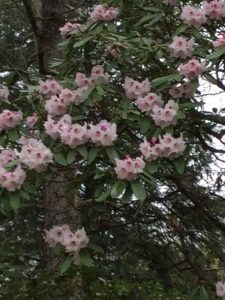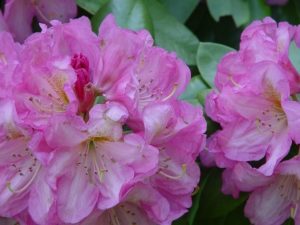The name Rhododendron comes from the Greek words “rodon” which means “rose” and “dendron” which means “tree”, hence Rose Tree.
There may be no better example of a “Rhododendron Tree” in Laurelwood Arboretum than R. ‘Babylon’ located on Long Valley Road. It was hybridized in 1955 by G. Reuthe, Ltd. in Kent, England. The original plant, which still grows in the arboretum today, was imported from England by John and Dorothy Knippenberg as part of their efforts to assemble masses of the hardiest varieties of rhododendrons in the arboretum. Two smaller examples of ‘Babylon’ are located on the downhill side of Ridge Road.
Now over fifteen feet in height, its large openly funnel-shaped flowers are 4” to 5” across with a deep red blotch in its throat. Both its seed parent (calophytum) and pollen parent (praevemum) from China had large crimson or deep red blotches in their throats and tree-like grow habit.


Located at the bottom of Long Valley Road, the R. ‘Catawbiense Album’ is one of our large Ironclad rhododendrons, which refers to their ability to withstand severe winter conditions. R. catawbiense was discovered on the top of Roan Mountain (North Carolina-Tennessee) in 1799 by English plant explorer John Fraser. The English hybrid ‘Catawbiense Album’ was produced by Anthony Waterer, a prolific hybridizer with many hardy hybrids. Its conical-shaped trusses hold 18 flowers.
Another tree-like rhododendron can be found at the corner of Long Valley Road and Ridge Road in the Dexter Garden. R. ‘Parker’s Pink’ of unknown parents was hybridized by renowned early pioneer Charles O. Dexter (pre-1943) at his estate in Sandwich, Massachusetts. Dexter’s hybrids are characterized by dense foliage, large stature and flowers of superior size and color. ‘Parker’s Pink’ is known to be one of Dexter’s best pinks. It has openly funnel-shaped, with wavy lobes held in trusses of about 12 flowers.
Several other mature, tree-like rhododendrons can be seen in the arboretum when it reopens setback along Ridge Road in front of Dorothy’s Way.

